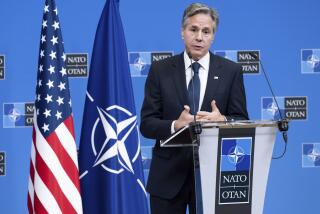A Budding Partnership
- Share via
MOSCOW — At their meeting here this week, President Bush and Russian President Vladimir V. Putin can take a dramatic step toward a new U.S.-Russian partnership by building upon a revolution in the geopolitics of Eurasia that has been rapidly unfolding since Sept. 11. Coming on the heels of last week’s agreements to cut nuclear arsenals and create a NATO-Russia council, burgeoning cooperation on Eurasian security could transform U.S.-Russian relations.
For centuries, Russia has dominated Central Asia and the Caucasus, all the while warning Western powers to steer clear. But Moscow is backing off. The U.S. military now has footholds in Uzbekistan, Kyrgyzstan, Tajikistan and Georgia, all a direct result of America’s war on terrorism. Bases in Uzbekistan, Kyrgyzstan and Tajikistan have facilitated U.S. operations in Afghanistan; U.S. troops in Georgia will help prepare forces there to attack terrorists in the country’s lawless Pankisi Gorge. Remarkably, U.S. forces have arrived under Russia’s approving eye.
The motivations behind Moscow’s cooperation go well beyond the fight against terrorism. Putin’s welcome of U.S. forces into Russia’s backyard is part of a profound shift in his country’s policy toward its neighbors. Before Putin, Moscow worked hard to limit Western influence in the former Soviet republics, saw Russia as the sole arbiter of regional disputes and showed interest in reconstituting an imperial zone. In contrast, Putin’s policy is based on economic pragmatism and recognition that Russia would pay too high a price for seeking to retain tight control over its periphery.
Economic reconstruction of Russia is Putin’s key goal, and foreign policy is to serve this end. His increased respect for the sovereignty of Russia’s smaller neighbors and his willingness to offer the West more economic and strategic access to Central Asia and the Caucasus follow logically.
The Russian president has gradually implemented his policy since 2000. Russia has dropped its opposition to the U.S.-backed Baku-Ceyhan pipeline, which would bring Caspian oil to the international market without crossing Russian territory. Russian companies are vying to participate in the project. In peace talks over the disputed region of Nagorno-Karabakh in Azerbaijan, Moscow has allowed Western countries to become influential partners in mediation. Russia also is withdrawing from many of its military bases across the region, fully aware that its presence is expensive and strains relations with the United States.
In orchestrating this about-face, Putin continues to encounter opposition from the military and others in the Russian elite, but his commanding political power has enabled him to prevail. Russia’s interest in countering the terrorist threat from Central Asia and the Caucasus has strengthened Putin’s pragmatic hand. As Alexei G. Arbatov, a leading defense expert in the Duma, or lower house of parliament, recently remarked, “Either Islamic terrorists operate there freely, or an American political and military presence begins building up. Since Russia today is unable, unfortunately, to liquidate hotbeds of terrorism on its own, there is no other choice.”
This evolution in Russian policy represents a remarkably rapid decline in Russia’s residual imperial mind-set. The Soviet Union existed only 11 years ago, and Russia is Eurasia’s dominant state, tempting it to encroach upon its weaker neighbors. Nonetheless, Moscow is retreating from decades of reliance on coercion and intimidation to sustain a sphere of influence, a momentous shift that opens up opportunities for the U.S. to develop a regional partnership with Russia.
The new U.S.-Russia partnership should focus on shared strategic, political and economic objectives. Fulfilling its strategic goals would entail a long-term U.S. military presence in Central Asia, a prospect most Russian elites privately support. The U.S. would use these bases to continue the fight against terrorism, of particular importance in light of the questionable future of U.S. access to bases in Saudi Arabia. The bases would also help combat Islamic radicals in the region who are reportedly funneling arms and money to Palestinian extremists. In addition, the U.S. would use its foothold in Central Asia to work with Moscow to limit China’s growing influence--Beijing’s intentions are of deep concern to Russian elites--and to manage conflict between India and Pakistan.
The political goal of a U.S.-Russian partnership would be to promote stability among the fragile states of Central Asia and the Caucasus. Many of these countries have weak domestic institutions and tenuous national identities; a corrupting drug trade further compromises the functioning of the state. Uzbekistan, Kazakhstan, Turkmenistan and Azerbaijan are governed by elderly, autocratic leaders and face potential crises over leadership succession. Georgia’s government has teetered on the edge of collapse and does not control major portions of the country. The United States and Russia should focus joint diplomacy on preserving the territorial integrity of these countries, ensuring smooth leadership transitions and enhancing efforts to fight drug trafficking.
The fragility of these states also increases the possibility that they could serve as terrorist havens. Extremists are already operating in Georgia. The United States should continue anti-terrorism training, increase efforts to improve the quality of domestic governance and press the government to take stronger steps against terrorists. The Russians should play a more constructive role in resolving the country’s separatist conflicts and should stop strong-arming Georgia through tactics such as threatening to cut off gas supplies.
On the economic front, the U.S. and Russia can work together to encourage development and reform throughout the region, the best insurance against both political instability and the spread of fundamentalism among Central Asia’s substantial Muslim population. Washington should seek to attract private investment to the area, a goal made easier by a U.S. military presence. The U.S. also should direct more foreign assistance to Central Asia, but without falling into the Cold War trap of providing aid directly to autocrats uninterested in economic reform or political liberalization. Instead, Washington should channel aid to the grass-roots level, supporting and nurturing new ideas among the next generation of leaders through educational exchanges, training programs and in-country projects that bypass the central government.
Although the Russian government does not have the resources to contribute financial assistance, it can take important steps to stimulate growth in the region. Moscow should ease new visa restrictions on Georgians, enabling them to again find work in Russia and send back home their earnings. The Russians should drop barriers on imports of Central Asian agricultural products. Moscow can use the growing economic clout stemming from its oil production to champion the development of Central Asia in international lending institutions and among Arab and Asian donors. And the U.S. and Russia must work together to tap the Caspian Basin’s major oil reserves, enhancing the region’s prosperity, bringing income to Russia’s energy industry and diversifying the West’s oil supplies.
Many issues will continue to divide the United States and Russia. But in Central Asia and the Caucasus, American and Russian objectives now closely coincide. Neither Washington nor Moscow can afford to overlook this opportunity to bring welcome stability to Eurasia’s southern rim while opening the door to a new level of cooperation.
More to Read
Sign up for Essential California
The most important California stories and recommendations in your inbox every morning.
You may occasionally receive promotional content from the Los Angeles Times.










